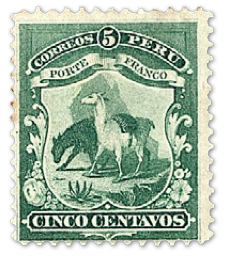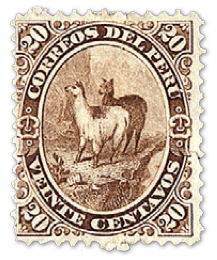This article endeavours to give a philatelic history of Peru from the mid-nineteenth century, with reference to the Pacific Steam Navigation Company and description of the early issues. It also contains useful historical information pertaining to Peru at this period.
Much of this article is based on a paper given by A. De La Torre Bueno in Mekeel’s Weekly Stamp News (c.1912).
Not until 1857, nearly a score of years after the first official issues of stamps had seen the light of day, did Peru join the ranks of the Governments with regularly established postal systems.
Prior to 1857 all mail matter had been carried and franked for its own account by the Pacific Steam Navigation Company, a steamship line plying between Panama and the ports on the west coast of South America, but in this year Peru took into her hands the care of the mails.
The government not having a supply of stamps at the time to avail itself of those which the Pacific Steam Navigation Company turned over to it, the 1 and 2 reales, until such time as it should receive its own stamps. This did not occur until the following year, 1858, when it put into circulation an issue consisting of three values; 1 dinero, 1peseta and ½ peseta.
The 1 dinero and 1 peseta (see top) were re-issued in 1859 and again in 1860, with slight modifications, in both years in the drawing; and in 1862-72 these were superseded by two new designs in the values of 1 dinero and one peseta, there being three printings of the latter in three different colours.
In 1866-7 a new issue of stamps made its appearance in an entirely new design (above) with values in centavos, the issue consisting of three stamps, their denominations being 5, 10, and 20 centavos.
Five years later, in 1871, there appeared a new issue consisting of two stamps of an entirely new design; their denominations being 2 and 5 centavos. The latter was for use in Callao, Lima and Chorrillos, the 2 centavos, being a new denomination for local use in Lima.
Up to this time all the stamps issued by Peru had been imperforate, except the 2 centavos, which was rouletted.
The first actually permanent and complete set of stamps issued by Peru was the 1874 issue, and consisted of seven stamps; ranging in value from 1 centavo to 1 sol.
The seven values of this issue and the designs of same were used for twenty-one years, 1871 to 1895, with changes in colour, grill and surcharges. During this period changes of an economic, as well as of an historic character, occurred.
Paper money had become so depreciated during these years that in 1880 Peru surcharged her stamps with the inscription, Universal Postal Union – Peru in an oval and the word plata (silver) in the centre. The stamps surcharged thus were to be used exclusively for foreign mail going to countries in the Universal Postal Union, and had to be paid for in silver (plata), or its equivalent, thus distinguishing them from those to be used for domestic mail, which were sold for paper money, without any premium being charged on account of the depreciated condition of the bills.
In 1879 a state of war existed between Peru and Chile and after a series of bloody encounters the Chileans occupied Lima on January 17th 1881, and the same year, after having taken possession of all the branches of the government, including the post office department, they surcharged the stamps with the Union Postal Universal surcharge, changing the word Peru to Lima, as the stamps were issued only from that post office. Following this they surcharged the 2, 5, 10 and 20 centavos and 1 sol, with the inscription Union Postal Universal in a new shape, known as horseshoe, and the Chilean arms.
Five stamps of this issue were again surcharged in 1883, after the Chileans had evacuated Peru, with a triangle, but without Union Postal Universal, which made it necessary to superimpose this surcharge, use being made this time of two ovals and of the horseshoe on the different stamps; later the horseshoe and the triangle were used together; this was followed by the Lima-Correos surcharges.
These same seven stamps were again issued in 1886 without the grill surcharges, and later, in 1889, the 10 centavos were surcharged with Union Postal Universal.
The surcharges on the Peruvian stamps are unique. First she surcharged her stamps on account of the economic condition of the country, next we see the conquering invader branding her stamps with his arms, and lastly, we find her honouring the memory of one of her sons by surcharging the stamps with his likeness.
Two of these surcharges, the first and the last, have no parallel in any other country, while the second finds its parallel in the stamps of Transvaal, surcharged with the initials V. R. I. (Victoria Regina Imperatrix).
Upon the death of General Bermudez, who followed General Cacares as President of Peru, the then (1894) current issue was surcharged with his bust. This surcharge was also combined with the Union Postal Universal horseshoe surcharge. After the Bermudez surcharged issue there followed a new set of five stamps, comprising two of the designs of the 1874 and three of the 1886 issues.
Following the death of General Bermudez, General Cacares again took the reins of government in hand and was ousted in the beginning of 1895 by Nicolas Pierola, who, to extol his achievement had a commemorative issue made in September that year consisting of seven stamps of the same denominations as the 1874 issues.
From 1895 to date there have appeared eleven issues, if we are to consider single stamps and surcharged stamp as separate issues.
The first of these, issue (1895), portrayed prominent figures in the conquest of Peru by the Spaniards when it was still in the Inca Empire. This issue contained one additional value, the 2 soles. In the issue of 1899 the additional values were introduced, the 5 and 10 soles, and in 1900 and 1902 there issued two stamps of 22 centavos, the primary object of which was to prepay the foreign postage, the rate of which, was reduced in 1905 to 12 centavos and a stamp of this denomination issued.
The 5 and 10 soles were dropped from the 1907 issue but a new denomination, the 4 centavos, was added; the 2 soles was dropped from the present issue (1909) and the 12 centavos for foreign postage again introduced, the present issue being thus reduced to the nine values, which are actually required.
The only stamps, of which the post office officials have not been able to gauge properly, the probable demand at the time of ordering the issue of the 1 centavo.
In 1897 this value became exhausted and the 1 centavo stamps surcharged Gobierno were used to prepay ordinary postage; in 1898 the 1 centavo postage due was surcharged Franquiero and used for ordinary postage, and in 1907 the 12 centavos was surcharged Un centavo. The stamp was also surcharged Dos centavos.
These latter two are the only cases in which Peru has surcharged any of her regular postage stamps with another value. Now we find that copies of the 1 centavo official are being used for ordinary postage.












Dear Sir,
I’m a philatelic journalist.
I will write an article on the Geo Chavez (pilot) joint stamp issue of Peru & Switzerland.
Can you send me URGENTLY a scanned copy of YOUR Peruvian stamp for this issue ? (300 dpi)
It should be issued in March 2010 !
Thanks a lot !
Best regards
J.L.Emmenegger
Hi,
We do not have the images you are after. However, may I suggest you contact the Peruvian Post direct (http://www.serpost.com.pe/) ? They should be able to help you…
Regards,
William
I collect Peru and am looking for a used copy (it is ok if there are some markings in it…) of the Bustamante specialized catalogue from the last 10 years or so.
Can somebody help me ?
Thank you very much !
For an interesting view of Peru in the 1920s, showing a steamer on one of the lakes in the Andes, visit http://www.youtube.com/watch?v=dWTJX6UgAQY
Hello, I have a 1895-1896 PERU 10 CENTS STAMP PROOF IN BLACK. I have tried to find information on it for quite sometime evenenlisting the aid of Sotherby’s for their expertise. To date I can not find any information on the stamp. I would be happy to forward any photos.
regards
Nadine
I am looking at an orange (or red) stamp of 20 soles with the inscription Republica Peruana. 1880 above the S.20 and 1881 below. is this a genuine stamp issued by Peru or was it issued by a company?
For more images of the stamps of Peru, see: http://stampsperu.com/
Great article! Great site!
Why are postage stamps of Peru called Bustamente?
See our recent stamp profile on President Bustamente…